The Design and Development of a Foot-Detection Approach Based on Seven-Foot Dimensions: A Case Study of a Virtual Try-On Shoe System Using Augmented Reality Techniques
Abstract
1. Introduction
- To propose a new system architecture for a feet detection approach based on markerless-based AR techniques that let ordinary people applicably measure their feet to an expert standard.
- To design and develop the foot-detection approach using markerless techniques based on seven-foot dimensions, measuring and visualizing shoe sizes accurately in a user-friendly manner.
- To prove that the proposed markerless-based approach based on seven-foot dimensions helps the system measure and visualize shoe sizes, and converge towards expert-based procedures.
2. Related Works
2.1. Feet Detection
2.2. Foot Detection Based on Real-Time-Based System
3. Overview Architecture of Proposed System
4. Proposed Seven-Dimension Model
4.1. Feet Dimension Extraction
4.2. Feet Detection Based on Semantic Relationships
| Algorithm 1 Feet Identification based on Semantic Relationships |
| Inputs: a set of seven-foot dimensions’ coordinates, C = {((x1, beginning, y1, beginning, z1, beginning), (x1, ending, y1, ending, z1, ending)), ((x2, beginning, y2, beginning, z2, beginning), (x2, ending, y2, ending, z2, ending)), …, ((x7, beginning, y7, beginning, z7, beginning), (x7, ending, y7, ending, z7, ending))} |
| Outputs: a graph of seven-foot dimensions, |
| 1. add Graph G = null
2. set 3. set 4. for in do 5. set ; 6. set ; 7. if in : continue; 8. else add to ; 9. end if 10. if in : continue; 11. else add to ; 12. end if 13. if in : continue; 14. else add to ; 15. end if 16. end for 17. add node to ; 18. add edge to ; 19. return |
4.3. Application Based on Feet Representation Using AR Techniques
| Algorithm 2 Seven-foot Dimensions Representation |
| Inputs: |
| Outputs: a set of seven-foot dimensions, D |
|
1. set
2. for each edge in do 3. set ; 4. set ; 5. set = 0; 6. ; 7. add to ; 8. end for 9. return |
5. Experimental Setup
5.1. Experimental Objectives
5.2. Data Set Description
5.3. Testing Metrics
5.4. Results and Discussions
6. Conclusions
Author Contributions
Funding
Institutional Review Board Statement
Informed Consent Statement
Data Availability Statement
Conflicts of Interest
Correction Statement
References
- Yang, P.; Shi, Y.; Li, S.; Tao, X.; Liu, Z.; Wang, X.; Wang, Z.L.; Chen, X. Monitoring the Degree of Comfort of Shoes In-Motion Using Triboelectric Pressure Sensors with an Ultrawide Detection Range. ACS Nano 2022, 16, 4654–4665. [Google Scholar] [CrossRef]
- Yuan, M.; Li, X.; Xu, J.; Jia, C.; Li, X. 3D foot scanning using multiple {RealSense} cameras. Multimed. Tools Appl. 2020, 80, 22773–22793. [Google Scholar] [CrossRef]
- Moore, Z.; Avsar, P.; Wilson, P.; Mairghani, M.; O’Connor, T.; Nugent, L.; Patton, D. Diabetic foot ulcers: Treatment overview and cost considerations. J. Wound Care 2021, 30, 786–791. [Google Scholar] [CrossRef]
- Jurca, A.; Žabkar, J.; Džeroski, S. Analysis of 1.2 million foot scans from North America, Europe and Asia. Sci. Rep. 2019, 9, 19155. [Google Scholar] [CrossRef]
- Shang, X.; Shen, Z.; Xiong, G.; Wang, F.-Y.; Liu, S.; Nyberg, T.R.; Wu, H.; Guo, C. Moving from mass customization to social manufacturing: A footwear industry case study. Int. J. Comput. Integr. Manuf. 2018, 32, 194–205. [Google Scholar] [CrossRef]
- Maruyama, M.; Tabata, S.; Watanabe, Y.; Ishikawa, M. Multi-pattern Embedded Phase Shifting Using a High-Speed Projector for Fast and Accurate Dynamic 3D Measurement. In Proceedings of the 2018 IEEE Winter Conference on Applications of Computer Vision (WACV), Lake Tahoe, NV, USA, 12–15 March 2018. [Google Scholar]
- Wu, G.; Li, D.; Hu, P.; Zhong, Y.; Pan, N. Automatic foot scanning and measurement based on multiple {RGB}-depth cameras. Text. Res. J. 2016, 88, 167–181. [Google Scholar] [CrossRef]
- Banwell, H.A.; Paris, M.E.; Mackintosh, S.; Williams, C.M. Paediatric flexible flat foot: How are we measuring it and are we getting it right? A systematic review. J. Foot Ankle Res. 2018, 11, 21. [Google Scholar] [CrossRef]
- Guo, K.; Xu, F.; Yu, T.; Liu, X.; Dai, Q.; Liu, Y. Real-time geometry, albedo and motion reconstruction using a single {RGBD} camera. ACM Trans. Graph. 2017, 36, 1. [Google Scholar] [CrossRef]
- Paulo, M.M.; Rita, P.; Oliveira, T.; Moro, S. Understanding mobile augmented reality adoption in a consumer context. J. Hosp. Tour. Technol. 2018, 9, 142–157. [Google Scholar] [CrossRef]
- Jiang, Q.; Sun, J.; Yang, C.; Gu, C. The Impact of Perceived Interactivity and Intrinsic Value on Users’ Continuance Intention in Using Mobile Augmented Reality Virtual Shoe-Try-On Function. Systems 2021, 10, 3. [Google Scholar] [CrossRef]
- Alkhamisi, A.O.; Monowar, M.M. Rise of Augmented Reality: Current and Future Application Areas. Int. J. Internet Distrib. Syst. 2013, 01, 25–34. [Google Scholar] [CrossRef]
- Pachoulakis, I. Augmented Reality Platforms for Virtual Fitting Rooms. Int. J. Multimed. Appl. 2012, 4, 35–46. [Google Scholar] [CrossRef]
- Saghazadeh, M.; Kitano, N.; Okura, T. Gender differences of foot characteristics in older Japanese adults using a 3D foot scanner. J. Foot Ankle Res. 2015, 8, 29. [Google Scholar] [CrossRef]
- Alsheikh, S.; AlGhofili, H.; Alageel, R.; Ababtain, O.; Alarify, G.; Alwehaibi, N.; Altoijry, A. Diabetic Foot Care: A Screening on Primary Care Providers’ Attitude and Practice in Riyadh, Saudi Arabia. Medicina 2022, 59, 64. [Google Scholar] [CrossRef]
- D’Angelo, G.; Della-Morte, D.; Pastore, D.; Donadel, G.; De Stefano, A.; Palmieri, F. Identifying patterns in multiple biomarkers to diagnose diabetic foot using an explainable genetic programming-based approach. Future Gener. Comput. Syst. 2023, 140, 138–150. [Google Scholar] [CrossRef]
- Thotad, P.N.; Bharamagoudar, G.R.; Anami, B.S. Diabetic foot ulcer detection using deep learning approaches. Sens. Int. 2023, 4, 100210. [Google Scholar] [CrossRef]
- Ahsan, M.; Naz, S.; Ahmad, R.; Ehsan, H.; Sikandar, A. A Deep Learning Approach for Diabetic Foot Ulcer Classification and Recognition. Information 2023, 14, 36. [Google Scholar] [CrossRef]
- Mei, Z.; Ivanov, K.; Zhao, G.; Wu, Y.; Liu, M.; Wang, L. Foot type classification using sensor-enabled footwear and 1D-CNN. Measurement 2020, 165, 108184. [Google Scholar] [CrossRef]
- Kini, K.R.; Madakyaru, M.; Harrou, F.; Sun, Y. Detecting pediatric foot deformities using plantar pressure measurements: A semi-supervised approach. IEEE Des. Test 2023, 1-1. [Google Scholar] [CrossRef]
- Chun, S.; Kong, S.; Mun, K.R.; Kim, J. A Foot-Arch Parameter Measurement System Using a RGB-D Camera. Sensors 2017, 17, 1796. [Google Scholar] [CrossRef]
- Kim, J.H.; Kim, M.; Park, M.; Yoo, J. Immersive interactive technologies and virtual shopping experiences: Differences in consumer perceptions between augmented reality (AR) and virtual reality (VR). Telemat. Inform. 2023, 77, 101936. [Google Scholar] [CrossRef]
- Serrano-Vergel, R.; Morillo, P.; Casas-Yrurzum, S.; Cruz-Neira, C. Exploring the Suitability of Using Virtual Reality and Augmented Reality for Anatomy Training. IEEE Trans. Hum.-Mach. Syst. 2023, 53, 378–389. [Google Scholar] [CrossRef]
- Sip, P.; Kozłowska, M.; Czysz, D.; Daroszewski, P.; Lisiński, P. Perspectives of Motor Functional Upper Extremity Recovery with the Use of Immersive Virtual Reality in Stroke Patients. Sensors 2023, 23, 712. [Google Scholar] [CrossRef]
- De Assis, G.A.; Brandão, A.F.; Correa, A.G.D.; Castellano, G. Characterization of Functional Connectivity in Chronic Stroke Subjects after Augmented Reality Training. Virtual Worlds 2023, 2, 1. [Google Scholar] [CrossRef]
- Jeung, D.; Jung, K.; Lee, H.J.; Hong, J. Augmented reality-based surgical guidance for wrist arthroscopy with bone-shift compensation. Comput. Methods Programs Biomed. 2023, 230, 107323. [Google Scholar] [CrossRef]
- Horváth, E.; Pozna, C.; Unger, M. Real-Time LIDAR-Based Urban Road and Sidewalk Detection for Autonomous Vehicles. Sensors 2021, 22, 194. [Google Scholar] [CrossRef]
- Teppati Losè, L.; Spreafico, A.; Chiabrando, F.; Giulio Tonolo, F. Apple LiDAR Sensor for 3D Surveying: Tests and Results in the Cultural Heritage Domain. Remote Sens. 2022, 14, 4157. [Google Scholar] [CrossRef]
- Luetzenburg, G.; Kroon, A.; Bjørk, A.A. Evaluation of the Apple iPhone 12 Pro LiDAR for an Application in Geosciences. Sci. Rep. 2021, 11, 22221. [Google Scholar] [CrossRef]
- Dalianis, H. Evaluation Metrics and Evaluation. In Clinical Text Mining; Springer: Berlin, Germany, 2018; pp. 45–53. ISBN 9783319785035. [Google Scholar]
- Adidas America, I. Men’s and Women’s Adidas Footwear Sizing. Available online: https://www.adidas.com/us/help/size_charts (accessed on 20 April 2023).
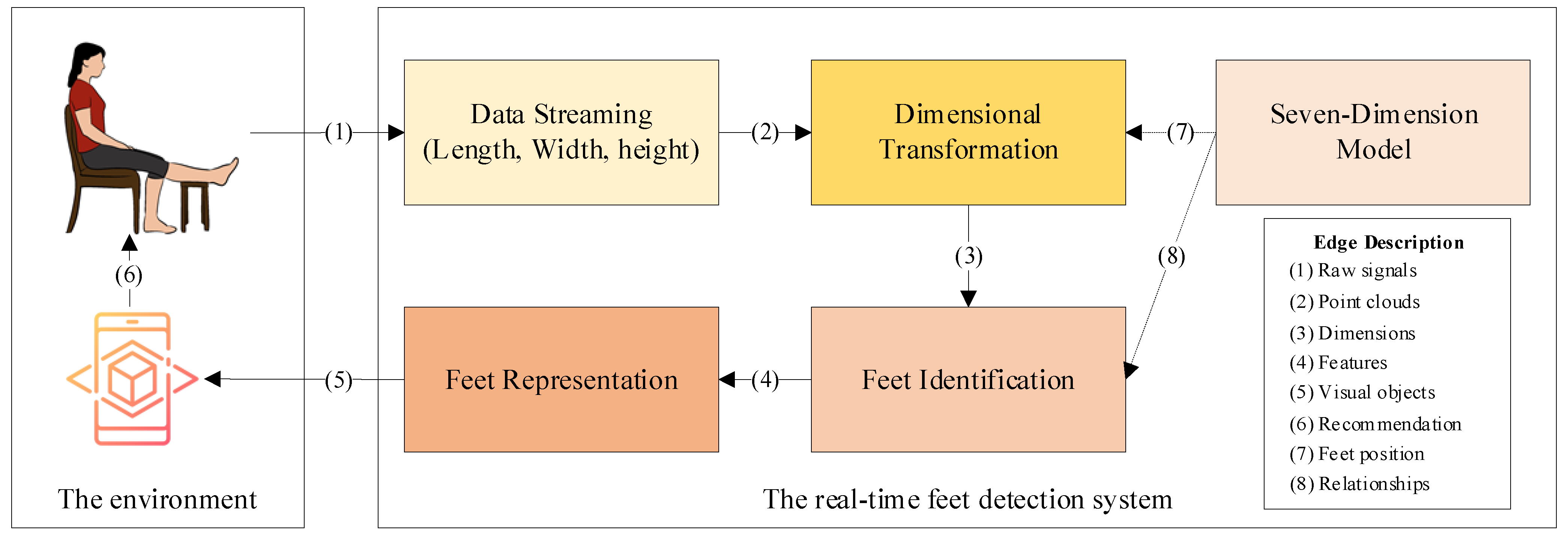
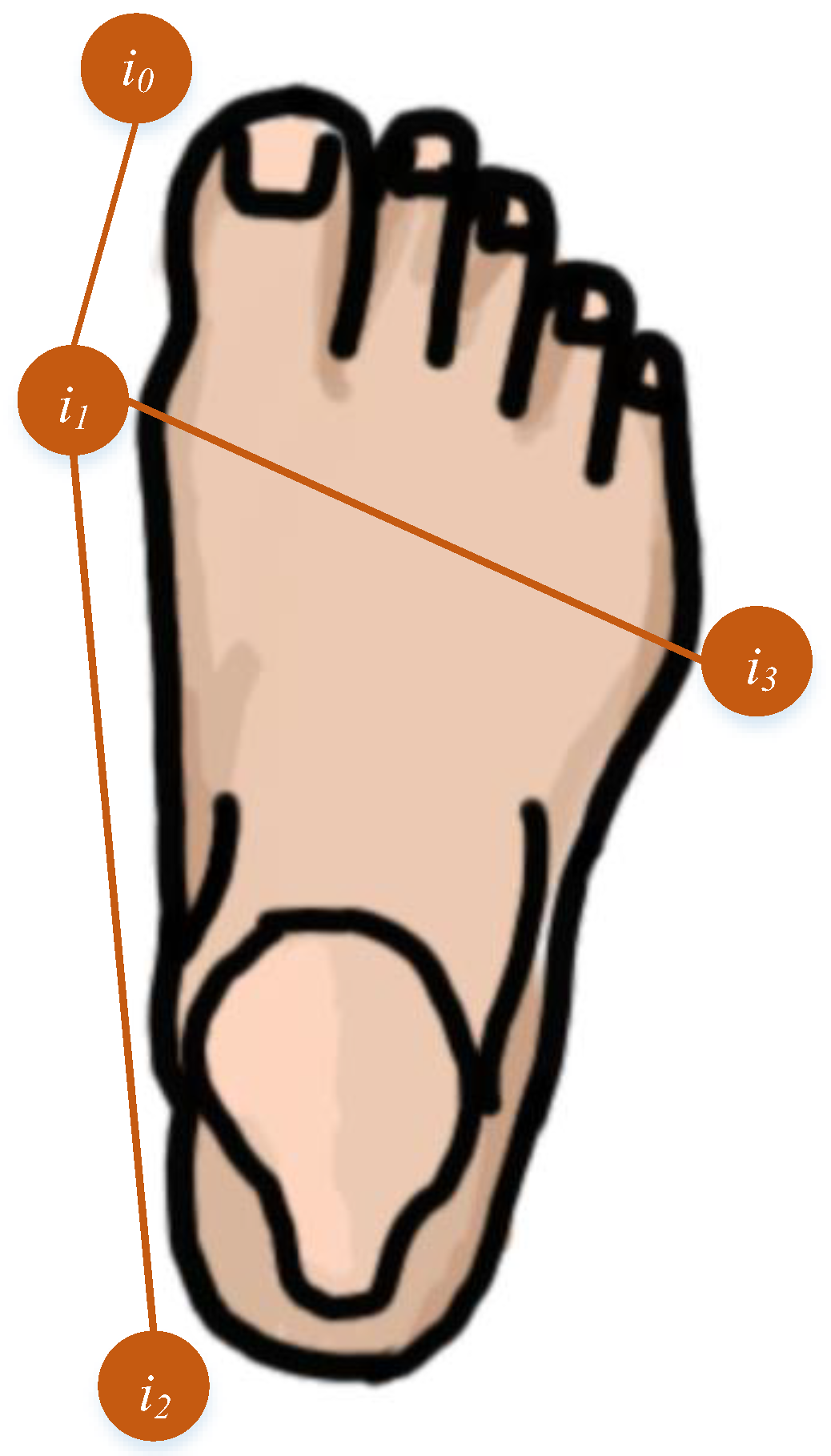
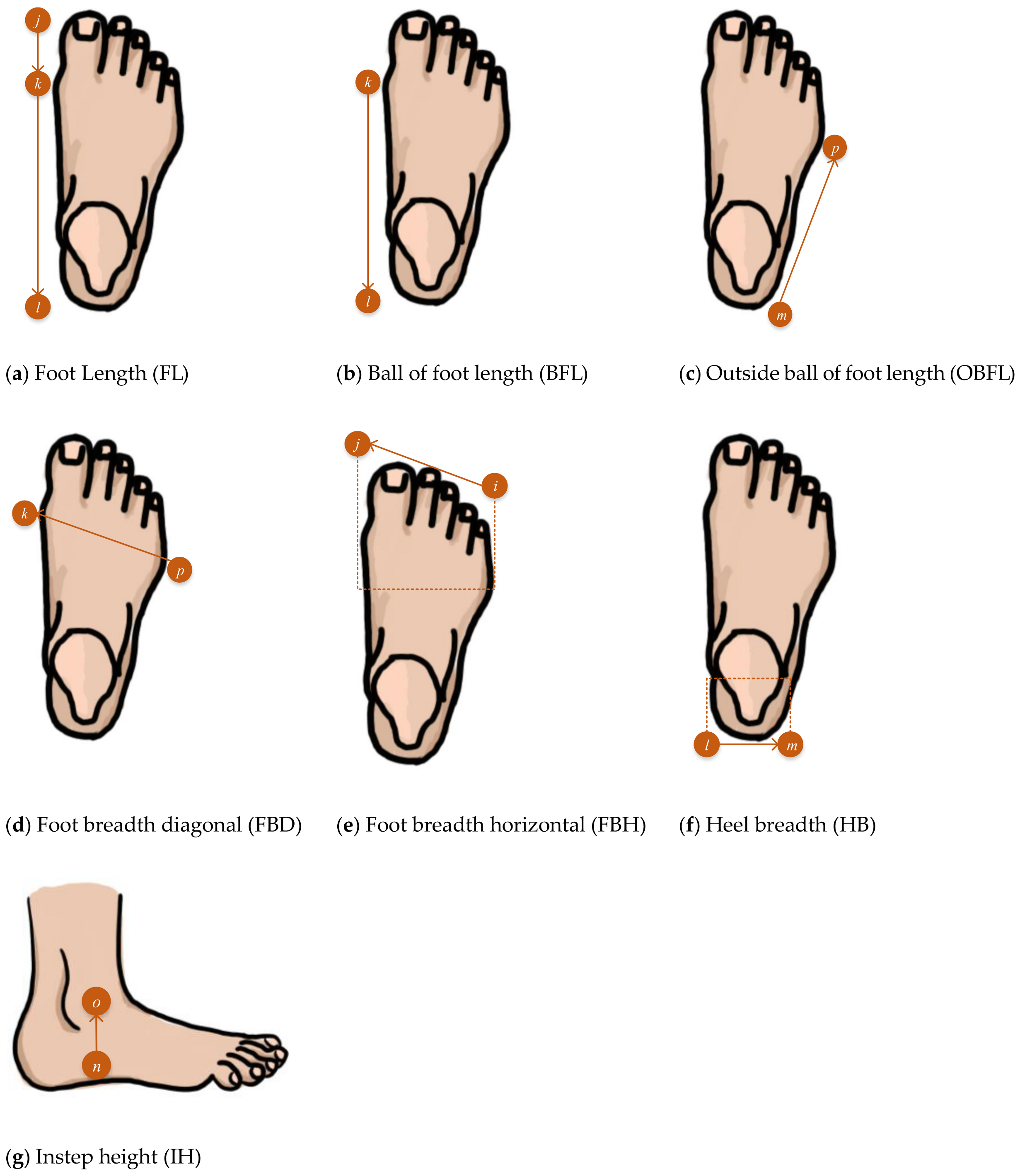
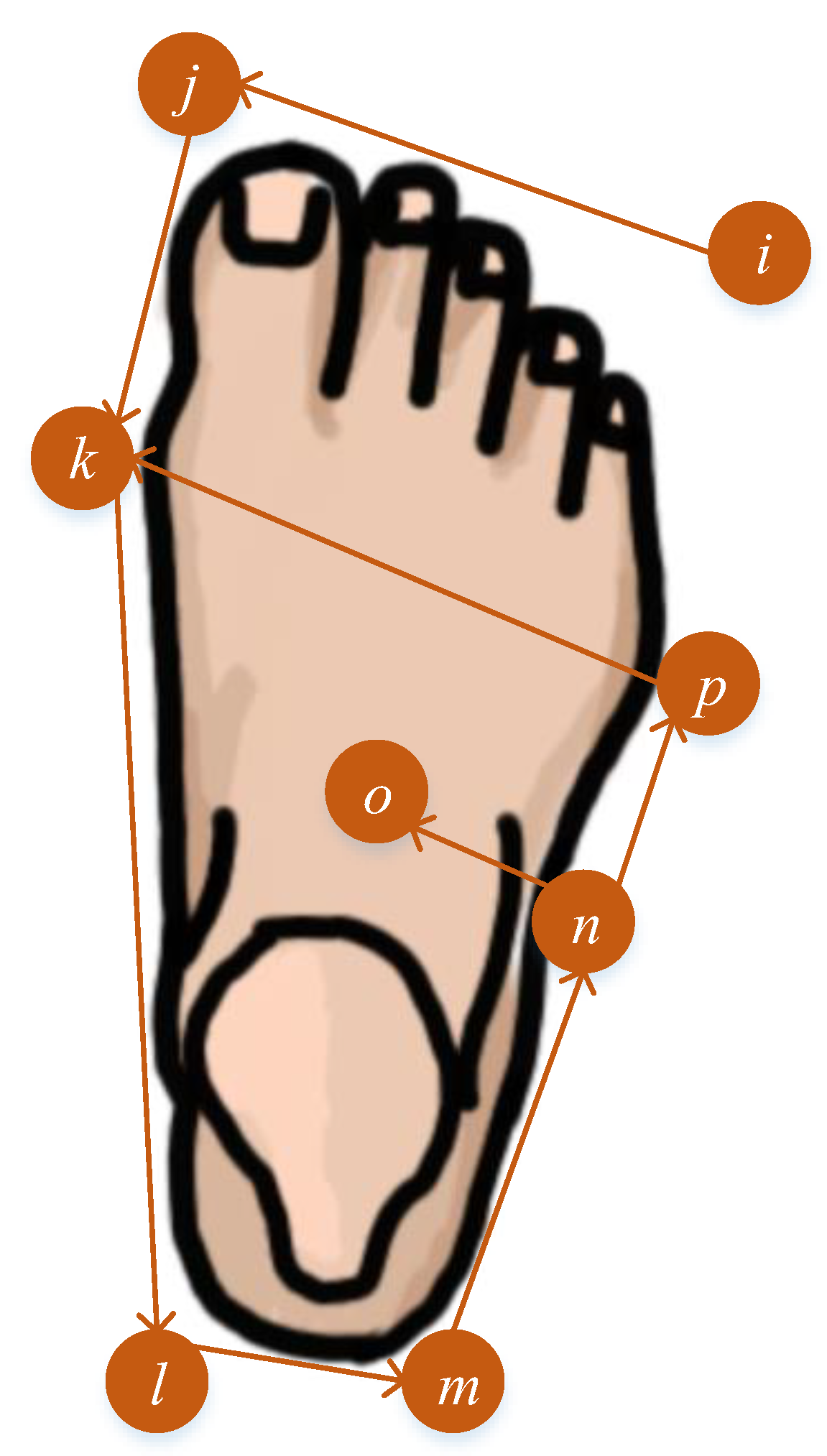
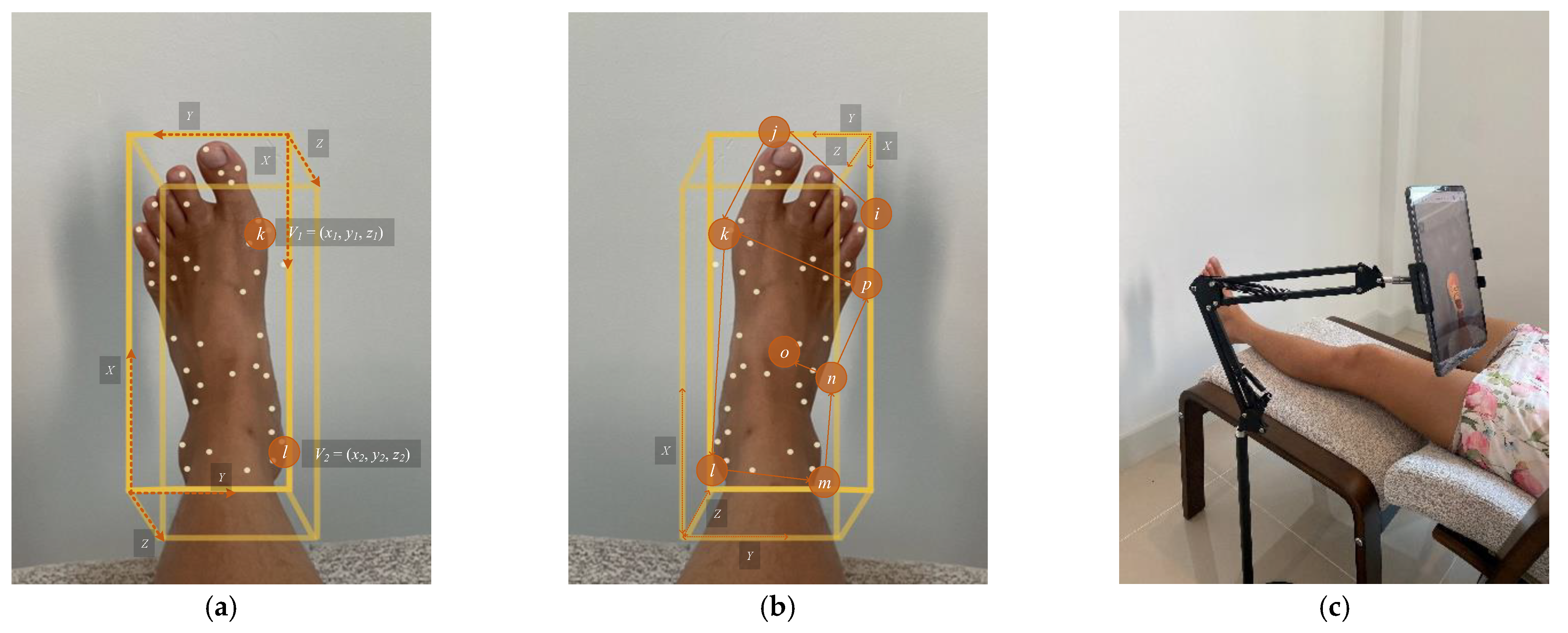
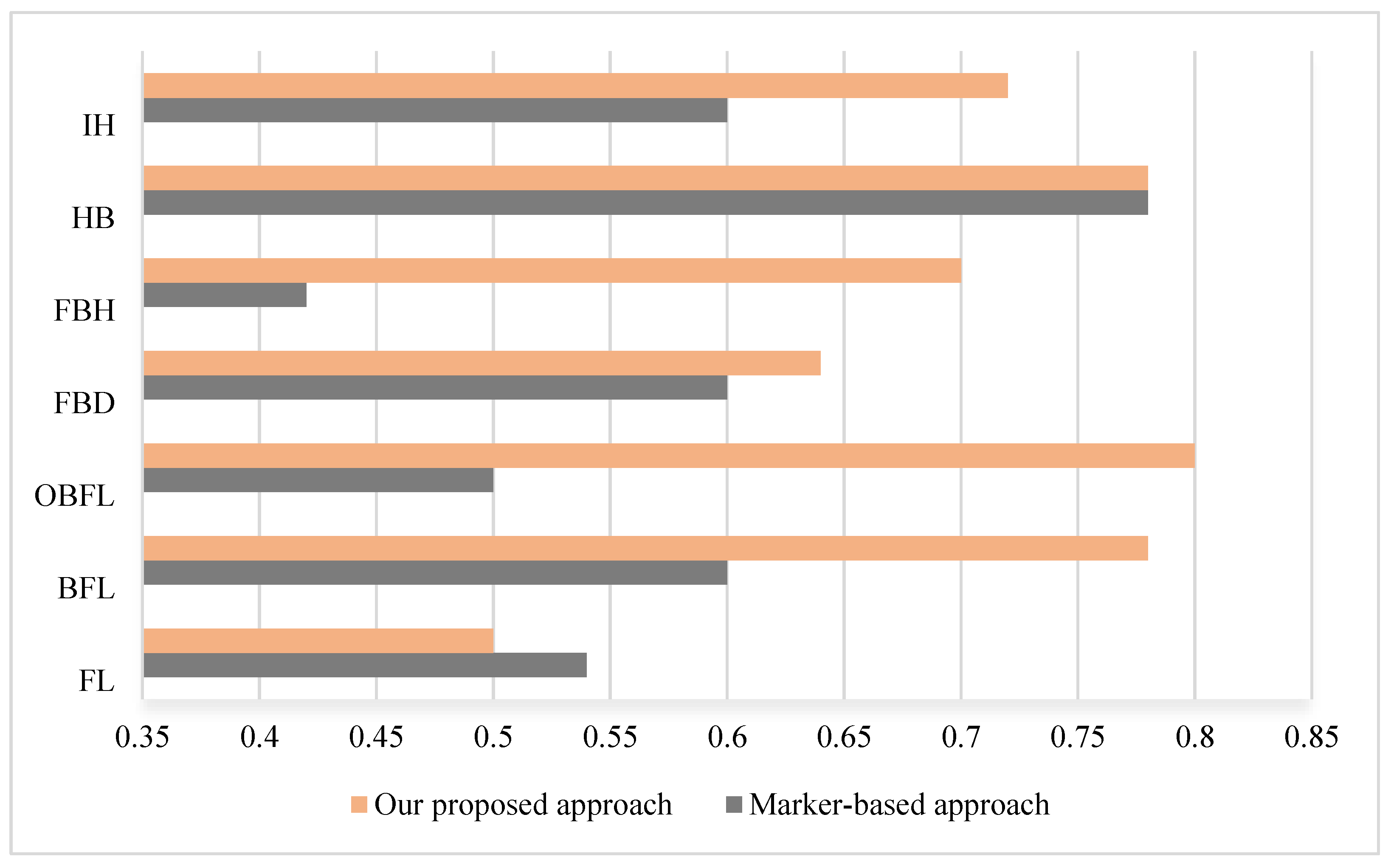
| Dimension | Algebraic Function | Description |
|---|---|---|
| FLdimension | FLdimension = (FLending, FLbeginning), FLbeginning = f (xFL, beginning, yFL, beginning, zFL, beginning), FLendending = f (xFL, ending, yFL, ending, zFL, ending), FLbeginning and FLending ⊆ Point Clouds | This determines the curves that naturally fit with a real-size user’s feet and plays an essential role in reducing exercise-related pain (e.g., running and jumping). |
| BFLdimension | BFLdimension = (BFLending, BFLbeginning), BFLbeginning = f (xBL, beginning, yBL, beginning, zBL, beginning), BFLending = f (xBL, ending, yBL, ending, zBL, ending), BFLbeginning and BFLending ⊆ Point Clouds | This extracts the foot axis between the end of the heel and the metatarsal tibial, reducing exercise-related pain (e.g., running and jumping). |
| OBFLdimension | OBFLdimension = (OBFLending, OBFLbeginning), OBFLbeginning = f (xOBFL, beginning, yOBFL, beginning, zOBFL, beginning), OBFLending = f (xOBFL, ending, yOBFL, ending, zOBFL, ending), OBFLbeginning and OBFLending ⊆ Point Clouds | A good measurement of this dimension helps prevent the causes of pain around the foot’s outside, including the forefoot, midfoot, and heel. |
| FBDdimension | FBDdimension = (FBDending, FBDbeginning), FBDbeginning = f (xFBD, beginning, yFBD, beginning, zFBD, beginning), FBDending = f (xFBD, ending, yFBD, ending, zFBD, ending), FBDbeginning and FBDending ⊆ Point Clouds | This extracts a measurement between a ball’s metatarsal tibial and metatarsal fibular bones. This helps identify shoe designs based on a suitable shape curve. |
| FBHdimension | FBHdimension = (FBHending, FBHbeginning), FBHbeginning = f (xFBH, beginning, yFBH, beginning, zFBH, beginning), FBHending = f (xFBH, ending, yFBH, ending, zFBH, ending), FBHbeginning and FBHending ⊆ Point Clouds | This determines suitable sizes based on the foot’s horizontal breadth. This avoids fundamental problems, such as narrow and loose shoes, both of which may cause an accident. |
| HBdimension | HBdimension = (HBending, HBbeginning), HBbeginning = f (xHB, beginning, yHB, beginning, zHB, beginning), HBending = f (xHB, ending, yHB, ending, zHB, ending), HBbeginning and HBending ⊆ Point Clouds | This measures the distance between the pterion point and the toe, called the heel size. It is an element to estimate the correct heel size that helps users walk and run properly. |
| IHdimension | IHdimension = (IHending, IHbegin), IHbeginning = f (xIH, beginning, yIH, beginning, zIH, beginning), IHending = f (xIH, ending, yIH, ending, zIH, ending), IHbeginning and IHending ⊆ Point Clouds | This dimension helps define the foot arch (e.g., a low instep defines a flat arch, which defines the foot shape as a flat foot). |
| Approach | Marker-Based Approach | Our Proposed Approach | ||||
|---|---|---|---|---|---|---|
| Dimension | Precision | Recall | F-Measure | Precision | Recall | F-Measure |
| FL | 0.46 | 0.65 | 0.54 | 0.37 | 0.77 | 0.50 |
| BFL | 0.46 | 0.87 | 0.60 | 0.63 | 1.00 | 0.78 |
| OBFL | 0.43 | 0.59 | 0.50 | 0.67 | 1.00 | 0.80 |
| FBD | 0.43 | 1.00 | 0.60 | 0.47 | 1.00 | 0.64 |
| FBH | 0.33 | 0.57 | 0.42 | 0.53 | 1.00 | 0.70 |
| HB | 0.63 | 1.00 | 0.78 | 0.63 | 1.00 | 0.78 |
| IH | 0.43 | 1.00 | 0.60 | 0.57 | 1.00 | 0.72 |
| Average | 0.45 | 0.81 | 0.58 | 0.55 | 0.97 | 0.70 |
Disclaimer/Publisher’s Note: The statements, opinions and data contained in all publications are solely those of the individual author(s) and contributor(s) and not of MDPI and/or the editor(s). MDPI and/or the editor(s) disclaim responsibility for any injury to people or property resulting from any ideas, methods, instructions or products referred to in the content. |
© 2023 by the authors. Licensee MDPI, Basel, Switzerland. This article is an open access article distributed under the terms and conditions of the Creative Commons Attribution (CC BY) license (https://creativecommons.org/licenses/by/4.0/).
Share and Cite
Kaewrat, C.; Boonbrahm, P.; Sahoh, B. The Design and Development of a Foot-Detection Approach Based on Seven-Foot Dimensions: A Case Study of a Virtual Try-On Shoe System Using Augmented Reality Techniques. Informatics 2023, 10, 48. https://doi.org/10.3390/informatics10020048
Kaewrat C, Boonbrahm P, Sahoh B. The Design and Development of a Foot-Detection Approach Based on Seven-Foot Dimensions: A Case Study of a Virtual Try-On Shoe System Using Augmented Reality Techniques. Informatics. 2023; 10(2):48. https://doi.org/10.3390/informatics10020048
Chicago/Turabian StyleKaewrat, Charlee, Poonpong Boonbrahm, and Bukhoree Sahoh. 2023. "The Design and Development of a Foot-Detection Approach Based on Seven-Foot Dimensions: A Case Study of a Virtual Try-On Shoe System Using Augmented Reality Techniques" Informatics 10, no. 2: 48. https://doi.org/10.3390/informatics10020048
APA StyleKaewrat, C., Boonbrahm, P., & Sahoh, B. (2023). The Design and Development of a Foot-Detection Approach Based on Seven-Foot Dimensions: A Case Study of a Virtual Try-On Shoe System Using Augmented Reality Techniques. Informatics, 10(2), 48. https://doi.org/10.3390/informatics10020048








